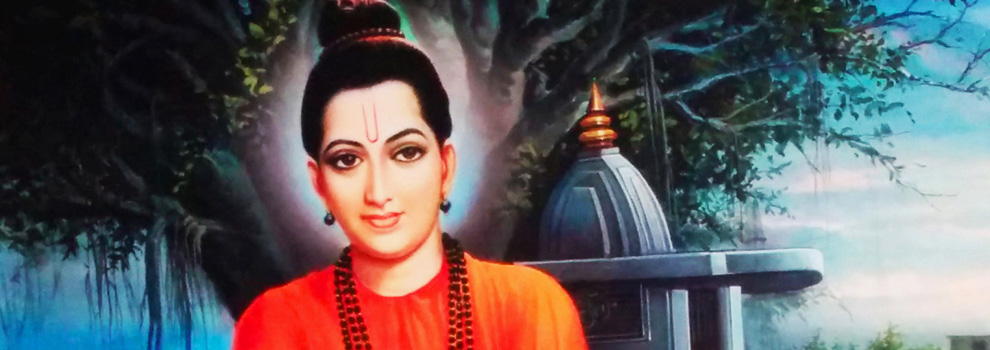Further Incarnations: Swamī Samartha
“I will incarnate whenever dharma touches bottom most level.”
- Srīpāda
Overview Incarnations
more about Swamī Samartha
Impressions of Swamī Samartha
Back: Narasimha Saraswati
 On several occasions, Srīpāda Srīvallabha declared that after coming as Narasimha Saraswati, his third manifestation will be Swamī Samartha: “I stay in intense penance for 300 years in Kadali Vana and conclude my incarnation in Prajnapura under the name Swamī Samartha.
On several occasions, Srīpāda Srīvallabha declared that after coming as Narasimha Saraswati, his third manifestation will be Swamī Samartha: “I stay in intense penance for 300 years in Kadali Vana and conclude my incarnation in Prajnapura under the name Swamī Samartha.
This declaration, however, remained unknown for centuries - the biography of Srīpāda was published for the first time in 2001. Swamī Samartha appeared in Akkalkot, a village in Maharashtra, India, in 1856. Therefore, he is also called Akkalkot Maharaj or Srī Swamī Samarth Maharaj by his devotees.
On one occasion, Swamī Samartha explained to a Western visitor that he came from the Kadali forest near Srīsailam and visited many pilgrim places along the Ganges, in the Himalayas and in Central India. He appeared during the year 1838 in Mangalwedha, Maharashtra, where he stayed several years. Afterwards he continued his pilgrimage until he settled in Akkalkot. When someone asked him about his life, he said, “I am the eternal Supreme Brahman with a background of banyan tree and originated from the incarnation of Lord Dattatreya.” Lord Dattatreya is compared to a banyan tree with many branches as his different manifestations.
According to the biography of Swamī Samartha, Narasimha Saraswati, the previous manifestation of Lord Dattatreya, went to the Himalayas after coming out from Kadali Vanam and stayed for an unknown period in a desolate forest north of the Ganges in deep samadhi. In the course of time an anthill grew over him. When a woodcutter went around the anthill, his axe happened to fall on it and he saw blood traces on the axe. He opened the anthill and saw a Yogi in meditation. He was shocked but the yogi said it was divine intention that the anthill got opened, for it was time for him to come out and continue his mission. The yogi that came out manifested in the form of Swamī Samartha, samartha in Sanskrit meaning strong, powerful. The mark of the axe wound did remain on the thigh of Srī Swamī Samartha.
Swamī Samartha came to Akkalkot in September-October 1858 on the invitation of a devotee by name Chintopant Tol and he stayed on the outskirts of the town. In his biography there are many stories about miraculous events and his ways of helping and uplifting the people. He was full of love and simplicity. He showered his grace on his devotees and helped them through crises, poverty and diseases to elevate them spiritually. He could get very angry seeing arrogance, hypocrisy, injustice, or immorality, and he punished the wrongdoers.
 First original photo of Swami Samartha, by Kodak Company’s photographer
First original photo of Swami Samartha, by Kodak Company’s photographer
On one occasion around 1870, a Western photographer from the Kodak Company wanted to take photos of Swamī Samartha for a campaign. Swamī’s devotees told him that he has to take permission before taking a photo. The photographer decided to do it secretly. He arranged the camera and took some shots from a distance. He developed the plate and gave it to the Swamī. Swamī Samartha gave it around. Everyone saw their own family deity but not the photo of Swamī. When the photographer said that this is a picture of Swamī Samartha, the Swamī laughed and said, “Do I look funny as this?” and gave the photo back. The photographer was perplexed – he saw a monkey on the picture. He realized his mistake and asked the Swamī for permission to take pictures. Swamī smiled and allowed him to take the pictures. The photos came out well.
For twenty two years Swamī Samartha was teaching, healing, and helping the spiritual seekers. Before his departure he gave indications in advance throughout the last year. Towards the end he fell sick but refused to take medicine. He was fully conscious when he sat in a lotus position and got himself absorbed in the supreme Self on a Tuesday in the year 1878.
After his departure he manifested himself in the house of a devotee, took some food and disappeared. And he appeared to many devotees telling them, “I have not gone, I am still living”.
Back: Narasimha Saraswati
Sources:
- Shree Vitthalrao Joshi Charities Trust: A Short Biography of Akkalkot Niwasi Shree Swami Samarth Maharaj English (PDF); Mumbai, 400 028, India 2006.
- ShreeSwami.org: Shree Swami Samarth 2016. Text from the book: C.B. Satpathy, Shirdi Sai Baba and other Perfect Masters. Sterling Paperbacks, 2001. Various reprints.
- Story behind Swami Samarth’s First Photos taken by Kodak Company
- Shankar Bhatt: Srīpāda Srīvallabha Charitāmrutam







